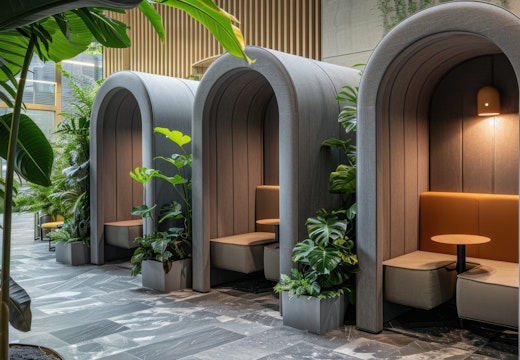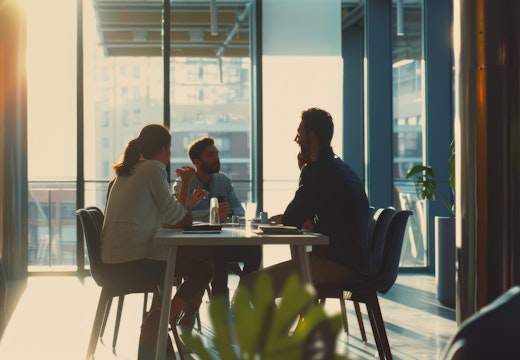New evidence that having a variety of spaces boosts creativity
How can we help employees think more inventively about their work? The answer may lie with having multiple spaces to work from according to a new Japanese study
All companies benefit from the creativity and engagement of their employees, but have they been creating office spaces to accentuate these attributes? In order to boost creativity within the workplace companies need to take a look at the science that underpins workplace creativity.
New research by Susumu Nagayama (2023), an associate professor at Hitotsubashi University in Japan, has shed light on how having multiple spaces to work in can make it more likely that people will think creatively.
Within his research, Nagayama analysed thousands of survey responses to explore the relationship between having multiple locations to work from and worker outcomes, such as engagement, creativity and wellbeing.
Positive association
The results illustrated a positive association between having a variety of spaces available to them and the three main outcomes. The strongest link was to creativity, and so an increased number of spaces available to employees is a must-have feature of any office looking to encourage creative tendencies. The research also discussed how creativity is significantly lower when people participate exclusively online as workers tend to be focused on the laptop in front of them rather than their ideas.
Previous research has also linked enhanced creative thinking to spaces with:
- A lack of environmental stressors (e.g., unpredictable loud noises, widely fluctuating temperatures; Byron, Khazanchi, and Nazarian, 2010)
- Biophilic design elements (Wijesooriya and Brambilla, 2021) such as the prominent use of natural materials (McCoy and Evans, 2002; Stora Enso, 2020)
- Surfaces in shades of green (Lichtenfeld, Elliot, Maier, and Pekrun, 2012; Studente, Seppala, and Sadowska, 2016)
- Moderate visual complexity (McCoy and Evans, 2002; Ceylan, Dul, and Aytac, 2008; Vohs, Redden, and Rahinel, 2013). This means they have about the same number of colors, shapes, patterns on view as in a residence designed by Frank Lloyd Wright as well as about the same apparent organization of those colours (Vaughan and Ostwald, 2014).
- More round design elements, rather than more angular design elements such as tables (Wu, Lu, Yan Chu, Wu, and Yang, 2021)
- Plenty of natural light (Meinel, Maier, Wagner, and Voigt, 2017)
- Warmer artificial lighting (Weitbrecht, Barwolff, Lischke, and Junger, 2015; Abdullah, Czerwinski, Mark, and Johns, 2016). Although slightly dimmer light levels can have the same effect (Steidle and Werth, 2013)
- A couple of green leafy plants in view (but not more than a couple) (e.g., Shibata and Suzuki, 2002; Studente, Seppala, and Sadowska, 2016; Hall and Knuth, 2019; Hahn, Essah, and Bianusa, 2021)
- A natural soundscape playing in the background (Browning and Walker, 2018)
- Opportunities to walk around the space, either indoors or outside (Oppezzo and Schwartz, 2014; Muralo and Handel, 2022)
- Slightly higher than average ceilings (Meyers-Levy and Zhu, 2007; Zhu and Mehta, 2017)
- Views of nature, through windows to outside or within the art inside the building (e.g., McCoy and Evans, 2002; Loder and Smith, 2013; Van Rompay and Joi, 2016; Batey, Hughes, Crick, and Toader, 2021)
- Comfortable amounts of environmental control (Martens, 2011; Veitch, 2012; Samani, Rasid, and Sofian, 2015)
For companies to start taking employee creativity seriously, this serves as a check-list for the design elements that can support employees in their quest to ideate.
For more updates on the latest research, read Dr Sally Augustin’s full Research Round-up in our Innovation Zone here.
Research Sources
Batey, D. Hughes, L. Crick, Nand A. Toader. 2021. ‘Designing Creative Spaces.’ Ergonomics, vol. 64, no. 1, pp. 139-146.
Bill Browning and Dakota Walker. 2018. An Ear for Nature: Psychoacoustic Strategies for Workplace Distractions and The Bottom Line, Terrapin Bright Green, LLC Retrieved February 6, 2024
Byron, S. Khazanchi and D. Nazarian. 2010. ‘The Relationship Between Stressors and Creativity: A Meta-Analysis Examining Competing Theoretical Models.’ Journal of Applied Psychology, vol. 95, no. 1, pp. 201-212.
Ceylan, J. Dul and S. Aytac. 2008. ‘Can the Office Environment Stimulate a Manager’s Creativity?’ Human Factors and Ergonomics in Manufacturing, vol. 18, no. 6, pp. 589-602.
Nalise Hahn, Emmanuel Essah, and Tijana Blanusa. 2021. ‘Biophilic Design and Office Planting: A Case Study of Effects on Perceived Health, Well-Being and Performance Metrics in the Workplace.’ Intelligent Buildings International, vol. 13, no. 4, pp. 241-260.
Charles Hall and Melinda Knuth. 2019. ‘An Update of the Literature Supporting the Well-Being Benefits of Plants: A Review of the Emotional and Mental Health Benefits of Plants.’ Journal of Environmental Horticulture, vol. 37, no. 1 pp. 30-38.
Stephanie Lichtenfeld, Andrew J. Elliot, Markus A. Maier, and Reinhard Pekrun. 2012. ‘Fertile Green: Green Facilitates Creative Performance.’ Personality and Social Psychology Bulletin, vol. 38, no. 6, pp. 784-797.
Angela Loder and Jerry Smith. 2013. ‘Designing Access to Nature.’ HealthCare Design, vol. 13, no. 5, pp. 58-63.
Yuri Martens. 2011. ‘Creative Workplace: Instrumental and Symbolic Support for Creativity. Facilities, vol. 29, no.1/2, pp. 63-79.
Janetta McCoy and Gary Evans. 2002. ‘The Potential Role of the Physical Environment in Fostering Creativity.’ Creativity Research Journal, vol. 14, no. 3-4, pp. 409-426.
Martin Meinel, Lukas Maier, Timm Wagner, and Kai-Ingo Voigt. 2017. ‘Designing Creativity-Enhancing Workspaces: A Critical Look at Empirical Evidence.’ Journal of Technology and Innovation Management, vol. 1, no. 1, pp. 1-11.
Joan Meyers-Levy and Rui Zhu. 2007. ‘The Influence of Ceiling Heights: The Effect of Priming on the Type of Processing People Use.’Journal of Consumer Research, vol. 34; no. 2, pp. 174-186.
Supriya Murali and Barbara Handel. 2022. ‘Motor Restrictions Impair Divergent Thinking During Walking and During Walking and During Sitting.’ Psychological Research, vol. 86, pp. 2144-4157.
Susumu Nagayama. 2023. ‘Does Working at Third Places Work? Multi-Locational Work for Engagement, Creativity, and Well-Being.’ Journal of Creativity, vol. 33, no. 3, 100070.
Marilyn Oppezzo and Daniel Schwartz. 2014. ‘Give Your Ideas Some Legs: The Positive Effect of Walking on Creative Thinking.’ Journal of Experimental Psychology: Learning, Memory, and Cognition, vol. 40, no. 4, pp. 1142-1152.
Sanaz Samani, Siti Rasid, and Saudah bt Sofian. 2015. ‘Individual Control Over the Physical Work Environment to Affect Creativity.’ Industrial Engineering and Management Systems, vol. 14, no. 1, pp. 94-103.
Seiji Shibata and Naoto Suzuki. 2002. ‘Effects of the Foliage Plant on Task Performance and Mood.’ Journal of Environmental Psychology, vol. 22, no. 3, pp. 265–72.
Anna Steidle and Lioba Werth. 2013. ‘Freedom from Constraints: Darkness and Dim Illusion Promote Creativity.’ Journal of Environmental Psychology, vol. 35, pp. 67-80.
Stora Enso. 2020. ’10 Reasons Why Wooden Buildings Are Good for You and the Scientific Research to Back It Up,‘ Retrieved February 6, 2024,
Studente, N. Seppalak and N. Sadowska, N. 2016. ‘Facilitating Creative Thinking in the Classroom: Investigating the Effects of Plants and the Colour Green on Visual and Verbal Creativity.’ Thinking Skills and Creativity, vol. 19, pp. 1-8.
Thomas van Rompay and Tineke Jol. 2016. ‘Wild and Free: Unpredictability and Spaciousness as Predictors of Creative Performance.’ Journal of Environmental Psychology, vol. 48, pp. 140-148.
Josephine Vaughan and Michael Ostwald. 2014. ‘Quantifying the Changing Visual Experience of Architecture.” In F. Madeo and M. Schnabel (eds.)Across: Architectural Research Through to Practice: 48th International Conference of the Architectural Science Association. The Architectural Science Association and Genova University Press, pp. 557-568.
Jennifer Veitch. 2012. ‘Work Environments.’ In Susan Clayton (ed.), The Oxford Handbook of Environmental and Conservation Psychology. Oxford University Press: New York, pp. 248-275.
Kathleen Vohs, Joseph Redden, and Ryan Rahinel. 2013. ‘Physical Order Produces Healthy Choices, Generosity, and Conventionality, Whereas Disorder Produces Creativity.’ Psychological Science, vol. 24, no.9, pp. 1860-1867.
Weitbrecht, H. Barwolff, A. Lischke, and S. Junger. 2015. ‘Effect of Light Color Temperature on Human Concentration and Creativity.’ Fortschritte der Neurologie, Psychiatrie, vol. 83, no. 6, pp. 344-348.
Niranjika Wijesooriya and Arianna Brambilla. 2021. ‘Bridging Biophilic Design and Environmentally Sustainable Design: A Critical Review.’ Journal of Cleaner Production, vol. 283, 124591.
Yueyan Wu, Chingyu Lu, Jianhui Yan, Xiao Chu, Meijiao Wu, and Zhi Yang. 2021. ‘Rounded or Angular? How the Physical Work Environment in Makerspaces Influences Makers’ Creativity.’ Journal of Environmental Psychology, vol.73, 101546.
Rui Zhu and Ravi Mehta. 2017. ‘Sensory Experiences and Consumer Creativity.’ Journal of the Association for Consumer Research, vol. 2, no. 4, pp. 472-484.








